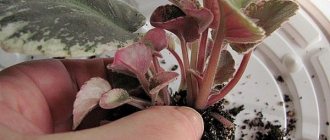How to rejuvenate indoor violets?
How to rejuvenate violet?
- Free the plant from the old pot and remove any remaining soil.
- Using a sharp blade, trim the stem, leaving 2-3 cm below the rosette.
- If the stem is very old, clean it a little, removing the hard crust.
- The cut can be sprinkled with coal.
- Remove the lower leaves and shape the rosette.
Interesting materials:
How to update applications on Sony TV? How to update applications on TV? How do I update my Sony Bravia TV software? How to update Toshiba TV software? How to update LG TV firmware via USB? How to update the firmware of a Philips TV? How to update the smart hub on a Samsung TV? How to update your Philips TV? How to update your TCL TV? How to update YouTube on BBK TV?
Features of care and cultivation
At first glance, violet seems to be a completely unpretentious plant. Replanting this flower is quite easy, and with proper care it blooms almost 10 months a year, with the exception of the hot summer period. But still, in order for the flower to meet your expectations, follow our tips for choosing a location and a pot for the plant.
Step 1
Place for violets.
Make sure that the plant does not stand in the shade; it loves light. But keep in mind that violets do not tolerate the burning rays of the sun. Therefore, on hot summer days it is better to curtain the windows. Some experts argue that it is advisable to place pots in the northern part of your home. Take these conditions into account to ensure maximum comfort for your flowers.
Step 2
Pot size.
A violet flower will grow even in a fairly small container with a small amount of soil. But in order for the plant to have a beautiful appearance, as well as large well-groomed leaves and large flowers, the size of the flower pot should be 10-15 cm in diameter and reach a height of about 10 cm. There is no need to plant this flower in huge pots; it will grow and lose its beautiful, neat appearance. view. In addition, the correct size of the pot can help provide decent care for the violet flower.
Step 3
Land for violets.
Stores sell special soil mixtures for Saintpaulias. You can also make the right mixture yourself. To do this, fill the pot to the middle with expanded clay, put a small block of charcoal, and fill the remaining space with ordinary dry soil. It is important to remember that the soil must allow moisture and air to pass through well and not stagnate, otherwise the plant will begin to rot.
Step 4
Fertilizers.
Special fertilizers are sold in specialized stores for flowering plants. It is recommended to fertilize this plant once every two weeks when the violet is actively blooming, and once every four weeks when the plant is dormant. You can add special fertilizers directly into a bowl of warm water, where you lower the pot for bottom watering of the violet.
How to properly care for violets so that the plant has enough moisture and continues to grow? Take care of proper watering and, if necessary, high-quality replanting.
Step 5
Watering.
Do not get carried away with frequent and intensive watering of violets, since large amounts of moisture are contraindicated for them. It is ideal if you water the violet from below, that is, place the pot in a container with warm, settled water. When the soil in the pot becomes evenly moist, this will mean that the violet has absorbed as much water as it needs. This method of watering will prevent water from getting on the leaves and flowers, and, in addition, will protect the plant from rotting.
Step 6
Transplanting violets.
Violets, like most indoor plants, should be replanted approximately once a year. Just change the soil and drain it. You can replant the violet into the same pot in which it grew previously, if the plant was comfortable in it. Periodically it is necessary to wash off the dust from the leaves of violets. This must be done very carefully, for example, with a weak shower stream with warm water. Never expose a wet plant to direct sunlight, as this will cause spots on its leaves or it will simply “burn.”
Why do violets have small leaves?
The formation of small leaf plates or grinding of existing ones is mainly associated with :
- Improper care;
- Or inappropriate growing conditions.
Violet leaves become smaller due to improper care.
Any plant requires knowledge of its biological or physiological characteristics and Saintpaulia is no exception . Violating the basic requirements for agricultural technology for growing these delicate but capricious plants, first of all, the appearance suffers, the bulk of which is occupied by green mass.
The fight for the appearance and health of indoor violets does not require much time or money. But, the necessary attention and care must be performed regularly .
Lack of daylight in winter
Light-loving violets can not only change the size of the leaf blades, but also change color due to insufficient light , especially in winter. Even on a lit windowsill during this period there will be insufficient daylight.
Experienced gardeners recommend using additional lighting for plants - phytolamps.
Light is the basis of life not only for violets, but for all plants. The green color of the leaves catches only a certain spectrum of rays , providing the synthesis of organic substances with its energy.
Varieties of indoor violet with dark green, variegated or fairly dense foliage require more daylight hours , and those with light green, wavy or pubescent foliage require less.
Effect of transplant
Replanting is always quite stressful for a plant . Therefore, the appearance of small leaves, with further proper care, is a temporary phenomenon.
Transplanting violets can have a bad effect on the condition of the leaves.
The main forces of the plant go to :
- Adaptation;
- And rooting in new soil.
If the transplant took place in high-quality soil with a balanced composition, then recovery will take a little time and the leaves will gain their size and shape .
Spider mite lesions
What to do if a spider mite appears on a violet? One of the most common causes of leaf shredding in Saintpaulia is the presence of spider mites . The problem for a grower is that it is difficult to spot at first glance.
It is necessary to strain your eyes or it is better to periodically examine the leaf plates with a magnifying glass in order to detect pests in time.
Red spider mites are a very dangerous pest for indoor plants. It moves very quickly and can harm more than one plant in a short time.
Harm is caused not only by adults, but also by larvae. The fight against such a pest, depending on its neglect, can take quite a long time.
Soil depletion
Any plant, including indoor violet, prefers soil containing a sufficient amount of :
- Nutrients;
- And minerals.
Over time, without additional nutrition, the soil becomes depleted . Lack of nutrition leads to the fact that the roots are left to take supplies from the leaves. Against the backdrop of soil depletion and roots taking up reserves, the leaves become smaller.
Read also: Chicken stew at home
Soil depletion can have a bad effect on the development of violets.
Timely application of fertilizers or replanting in high-quality soil will help avoid loss of the size and appearance of the leaf blades.
Root system rotting or drying out
Appearance, health, full flowering - this is an important part of the work of the root system . It has a great influence on the work of the roots and, accordingly, on the condition and appearance of the plant, these are:
- Poor quality soil;
- Overflow;
- Overdrying;
- Unsuitable container.
Overwatering causes putrefactive processes in the root part, which significantly inhibits the supply of nutrition to the leaves . Plus, from overflowing, the soil becomes compacted, and loss occurs:
- Air permeability;
- And moisture absorption.
When overdrying, increased evaporation occurs from the above-ground part of the plant.
What do you need to know to grow a healthy plant from a leaf?
If the plant is grown with additional lighting, then a leaf for rooting can be taken at any time of the year. If there is no additional lighting, then it is better to harvest leaf cuttings in the spring, during the period of active growth. You can take a leaf cutting from a flowering plant, but keep in mind that if you break the cutting from under the peduncle, the peduncle will certainly die. To root, break off a leaf from the mother plant by pressing on the base of the petiole near the stem. You can cut the leaf, but you must break off the rest of the petiole, because it may rot. It is better to use boiled water to root leaves. When the leaf cuttings have roots (about 1 cm), the leaf cuttings must be planted in an earthen substrate. The earthen lump should not dry out. Water should not be poured into the tray and stand there. It is very clear whether watering is required and how much water is needed when keeping violets in transparent plastic cups.
Fungal diseases of violets (rot)
The plant becomes as if boiled with transparent brown leaves and stem, the baby dies within 3 days. If you cut the cutting and try to root it, it will also die. What is this and how to deal with it? An infectious fungal disease is caused by fungi from the genus: Fusarium and Pythium, less commonly Phytophthora. This disease develops rapidly, and if you hesitate, the plant cannot be saved. Since it is very difficult to treat fungal diseases, it is better not to create conditions for their occurrence. After all, the root cause of plant death is good, generous watering after significant drying. When plants become too dry, when the wilting stage begins, part of the root system dies. And if at this time you water the weakened plant abundantly, then it will have practically nothing to drink - most of the root hairs have died. And a long stay in excessively wet soil with damage to the integrity of the root system leads to rotting of the roots and the rapid spread of this fungal infection throughout the plant. As a result, the leaves first become flabby and soft, and then dead and brown. What to do? How to fight fungal diseases? Ideally, do not create conditions for their occurrence, namely:
1. do not overheat or overcool plants (temperature optimum 18-23oC);
2. watering “as needed”, and not 1 (2.3) times a week. Many substrates, when dried, change their color to a lighter shade, which is a signal for watering;
3. when composing the substrate, it is necessary to introduce a sufficient amount of cultivators (perlite, vermiculite, coarse sand) so that the root system is always provided with the amount of air it needs;
4. when watering a plant through a tray, do not leave undrinkable water for more than 0.5 hours;
5. If the plant is very dry, the first watering should not be abundant.
Read also: How to grow orbiz growing balls
6. increase the natural immunity of plants - from time to time spray them with a solution of epin or zircon.
9. to reduce the number of fungal pathogens in the collection - this is a disinfectant spill of the soil with a solution of “Maxim”, HOM, Ordan, a preventive spill with Fitosporin and Trichodermin. These activities are especially indicated in the summer heat, when the likelihood of fungal infections is greatest.
10. keeping utensils and tools clean.
What to do if a violet produces many leaves and few flower stalks?
Most likely, this is overfeeding with nitrogen fertilizers. Wait a month and a half and feed the plant with fertilizer with a high phosphorus content. If there are a lot of leaves, remove 1 – 2 lower tiers of leaves (don’t forget to sprinkle the wounds with charcoal powder).
The violet brings true pleasure to the gardener when large, dark green leaves with a small fluff frame a bouquet of amazingly beautiful flowers. But sometimes the picture changes and the plant loses its attractiveness.











